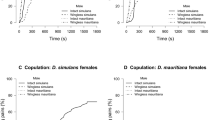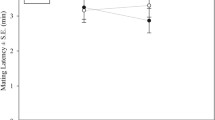Abstract
Drosophila ananassae and D. pallidosa are closely related, sympatric species that lack postmating isolation. Sexual isolation has been considered important in maintaining them as independent species. To clarify the behavioral processes leading to sexual isolation, we analyzed behavioral sequences and examined the effect of courtship song on mating success and on behaviors of both sexes by surgically removing male wings (song generators), female aristae (song receivers), or female wings (means of fluttering). We found that heterospecific courtship songs evoked female wing fluttering, whereas conspecific courtship song did not. Furthermore, female wing fluttering made courting males discontinue courtship. These findings suggest that strong sexual isolation is achieved through the following behavioral sequence: heterospecific song→female wing fluttering→courtship discontinuation.

Similar content being viewed by others
References
Bennet-Clark HC, Ewing AW (1969) Pulse interval as a critical parameter in the courtship song of Drosophila melanogaster. Anim Behav 17:755–759
Bishop YMM, Fienberg SE, Holland PW (1975) Discrete Multivariate Analysis: Theory and Practice. MIT Press, Cambridge, Massachusetts
Bixler A, Jenkins JB, Tompkins L, McRobert SP (1992) Identification of acoustic stimuli that mediate sexual behavior in Drosophila busckii (Diptera: Drosophilidae). J Insect Behav 5:469–478
Bock IR, Wheeler MR (1972) The Drosophila melanogaster species group. Texas Univ Publ 7213:1–102
Chapman RF (1998) The insects: structure and function, 4th edn. Cambridge University Press, Cambridge
Choe JC, Crespi BJ (1997) The evolution of mating systems in insects and arachnids. Cambridge University Press, Cambridge
Cobb M, Ferveur J-F (1996) Evolution and genetic control of mate recognition and stimulation in Drosophila. Behav Processes 35:35–54
Coyne JA, Orr HA (1989) Patterns of speciation in Drosophila. Evolution 43:362–381
Coyne JA, Orr HA (2004) Speciation. Sinauer Associates, Sunderland Masachusetts
Crossley SA (1986) Courtship sounds and behaviour in the four species of the Drosophila bipectinata complex. Anim Behav 34:1146–1159
Crossley SA, Bennet-Clark HC (1993) The response of Drosophila parabipectinata to simulated courtship songs. Anim Behav 45:559–570
Demerec M (1950) Biology of drosophila. Cold Spring Harbor Laboratory Press, Cold Spring Harbor, New York
Doi M, Nemoto T, Nakanishi H, Kuwahara Y, Oguma Y (1997) Behavioral response of males to major sex pheromone component, (Z,Z)-5,25-hentriacontadiene, of Drosophila ananassae females. J Chem Ecol 23:2067–2078
Doi M, Matsuda M, Tomaru M, Matsubayashi H, Oguma Y (2001) A locus for female discrimination behavior causing sexual isolation in Drosophila. Proc Natl Acad Sci U S A 98:6714–6719
Everitt BS (1977) The analysis of contingency tables. Chapman and Hall, London
Ewing AW (1978) The antenna of Drosophila as a ‘love song’ receptor. Physiol Entomol 3:33–36
Ewing AW (1983) Functional aspects of Drosophila courtship. Biol Rev 58:275–292
Ewing AW (1989) Arthropod bioacoustics: neurobiology and behaviour. Cornell University Press, Ithaca, New York
Ewing AW, Bennet-Clark HC (1968) The courtship songs of Drosophila. Behaviour 31:288–301
Fagen RM, Young DY (1978) Temporal patterns of behaviors: duration, intervals, latencies, and sequences. In: Colgan PW (ed) Quantitative ethology. Academic, New York, pp 79–114
Futch DG (1966) III. A study of speciation in South Pacific populations of Drosophila ananassae. Texas Univ Publ 6615:79–120
Futch DG (1973) On the ethological differentiation of Drosophila ananassae and Drosophila pallidosa in Samoa. Evolution 27:456–467
Greenspan RJ, Ferveur J-F (2000) Courtship in Drosophila. Annu Rev Genet 34:205–232
Hoikkala A, Aspi J (1993) Criteria of female mate choice in Drosophila littoralis, D. montana, and D. ezoana. Evolution 47:768–777
Ikeda H (1985) Nature of the sound produced by courtship-inhibiting behavior of the male Drosophila mercatorum. Experientia 41:1197–1199
Isoherranen E, Aspi J, Hoikkala A (1999) Variation and consistency of female preferences for stimulated courtship songs in Drosophila virilis. Anim Behav 57:619–625
Kirkpatrick M (1982) Sexual selection and the evolution of female choice. Evolution 36:1–12
Kyriacou CP, Hall JC (1982) The function of courtship song rhythms in Drosophila. Anim Behav 30:794–801
Lande R (1981) Models of speciation by sexual selection on polygenic traits. Proc Natl Acad Sci U S A 78:3721–3725
Liimatainen J, Hoikkala A, Aspi J, Welbergen PH (1992) Courtship in Drosophila montana: the effects of male auditory signals on the behaviour of flies. Anim Behav 43:35–48
Nemoto T, Doi M, Oshio K, Matsubayashi H, Oguma Y, Suzuki T, Kuwahara Y (1994) (Z,Z)-5,27-tritriacontadiene: major sex pheromone of Drosophila pallidosa (Diptera; Drosophilidae). J Chem Ecol 20:3029–3037
Noor MAF, Aquadro CF (1998) Courtship songs of Drosophila pseudoobscura and D. persimilis: analysis of variation. Anim Behav 56:115–125
Oguma Y (1993) Sexual behavior (chapter 10). In: Tobari YN (ed) Drosophila ananassae: genetical and biological aspects. Japan Scientific Societies Press, Tokyo, pp 199–207
Oguma Y, Wen S, Tomaru M, Matsubayashi H, Peng T (1995) Reproductive isolation between Drosophila lini and its siblings. Japanese Journal of Genetics 70:311–320
Paillette M, Ikeda H, Jallon J-M (1991) A new acoustic signal of the fruit-flies Drosophila simulans and D. melanogaster. Bioacoustics 3:247–254
Pomiankowski A, Iwasa Y, Nee S (1991) The evolution of costly mate preferences I. Fisher and biased mutation. Evolution 45:1422–1430
Ritchie MG, Townhill RM, Hoikkala A (1998) Female preference for fly song: playback experiments confirm the target of sexual isolation. Anim Behav 56:713–717
Ritchie MG, Halsey EJ, Gleason JM (1999) Drosophila song as species-specific mating signal and the behavioural importance of Kyriacou & Hall cycles in D. melanogaster song. Anim Behav 58:649–657
Sakai T, Isono K, Tomaru M, Oguma Y (1997) Light-affected male following behavior is involved in light-dependent mating in Drosophila melanogaster. Genes & Genet Syst 72:275–281
Satokangas P, Liimatainen JO, Hoikkala A (1994) Songs produced by the females of the Drosophila virilis group of species. Behav Genet 24:263–272
Spieth HT (1952) Mating behavior within the genus Drosophila (Diptera). Bull Am Mus Nat Hist 99:395–474
Spieth HT (1966) V. Mating behavior of D. ananassae and ananassae-like flies from the Pacific. Texas Univ Publ 6615:133–145
Stocker RF (1994) The organization of the chemosensory system in Drosophila melanogaster: a review. Cell Tissue Res 275:3–26
Stone WS, Wheeler MR, Wilson FD, Gerstenberg VL, Yang H (1966) I. Genetic studies of natural population of Drosophila. II. Pacific island populations. Texas Univ Publ 6615:1–36
Suvanto L, Hoikkala A, Liimatainen JO (1994) Secondary courtship songs and inhibitory songs of Drosophila virilis-group males. Behav Genet 24:85–94
Takimoto G, Higashi M, Yamamura N (2000) A deterministic genetic model for sympatric speciation by sexual selection. Evolution 54:1870–1881
Tobari YN (1993) Drosophila ananassae: genetical and biological aspects. Scientific Societies Press, Tokyo, Japan
Tomaru M, Matsubayashi H, Oguma Y (1995) Heterospecific inter-pulse intervals of courtship song elicit female rejection in Drosophila biauraria. Anim Behav 50:905–914
Tomaru M, Matsubayashi H, Oguma Y (1998) Effects of courtship song in interspecific crosses among the species of the Drosophila auraria complex (Diptera: Drosophiladae). J Insect Behav 11:383–398
Vuoristo M, Isoherranen E, Hoikkala A (1996) Female wing spreading as acceptance signal in the Drosophila virilis group of species. J Insect Behav 9:505–516
Yamada H, Matsuda M, Oguma Y (2002a) Genetics of sexual isolation based on courtship song between two sympatric species: Drosophila ananassae and D. pallidosa. Genetica 116:225–237
Yamada H, Sakai T, Tomaru M, Doi M, Matsuda M, Oguma Y (2002b) Search for species-specific mating signal in courtship songs of sympatric sibling species, Drosophila ananassae and D. pallidosa. Genes & Genet Syst 77:97–106
Zar JH (1998) Biostatistical analysis, 4th edn. Prentice Hall, New Jersey
Acknowledgments
We thank Dr Y. N. Tobari for providing strains and helpful comments and Dr M. G. Ritchie and anonymous reviewers for kindly providing valuable comments on the manuscript. This research was supported by Grant-in-Aid for Scientific Research on Priority Areas from the Ministry of Education, Culture, Sports, Science and Technology (MEXT) to YO. MM also thanks National Bio-Resource Project (NBRP) of MEXT for supporting him for Drosophila resources.
Author information
Authors and Affiliations
Corresponding author
Rights and permissions
About this article
Cite this article
Yamada, H., Tomaru, M., Matsuda, M. et al. Behavioral Sequence Leading to Sexual Isolation Between Drosophila ananassae and D. pallidosa . J Insect Behav 21, 222–239 (2008). https://doi.org/10.1007/s10905-008-9122-7
Revised:
Accepted:
Published:
Issue Date:
DOI: https://doi.org/10.1007/s10905-008-9122-7




